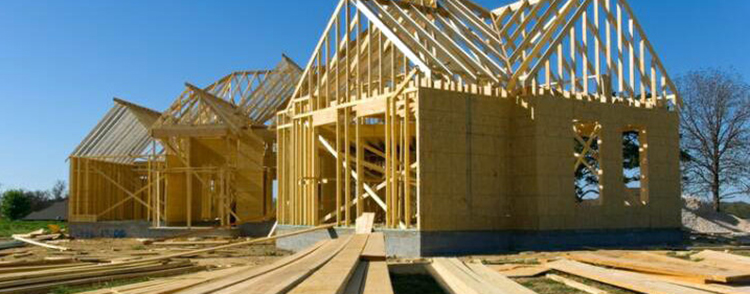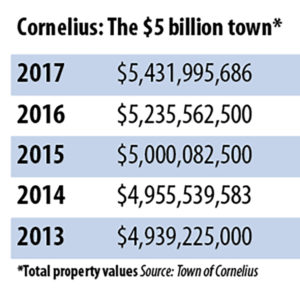
By Dave Yochum. With home prices here climbing on the order of 5, 10 and even 15 percent during the past 18 months, some people are looking at extensive renovations, outright tear-downs and infill development where property has sat empty for decades.
Developer John Ogburn wants to build five homes on an infill parcel on Queen Street, just west of North Main. The houses would likely be in the $400,000 range, considerably higher than the modest homes nearby.
 Decades ago some of them housed workers and merchants in this former mill town.
Decades ago some of them housed workers and merchants in this former mill town.
Gentrification is under way now in earnest. Some people say it’s all good.
“Make no mistake—increasing property values in the town of Cornelius is a universally good thing. New in-fill development, which must invariably add substantial value to the nearby area or neighborhood—or should not be approved—is great to see,” said Dave Gilroy, a powerful free-market thinker on the Board of Commissioners.
“It is our job at the Town Board level to ensure the highest standards for what is approved to be sure that we are not going backward, diminishing the current character of parts of our town in any way, or over-developing relative to what our roads can support,” Gilroy says.
“Some of our best new development opportunities will come in the form of gentrification of blighted or run-down areas, especially on the historic east side of town,” he said.
Older homes are all around Cornelius. Some are being remodeled and improved, while others, especially those on high-dollar waterfront lots, are being torn down and replaced with much more significant homes. Two nice homes, if they’re next to each other and available for sale, stand a fair chance of being torn down and being replaced with a multimillion-dollar mansion.
Town Planning Director Wayne Herron says a half dozen $2 million homes have been built in Cornelius during the past two years.
On the east side of town, rising land values are making odd and leftover lots more desirable for the higher-price houses new homebuyers are looking for.
“We’re definitely seeing a trend around in-fill that is going to be what we will see on the residential side for the foreseeable future. A lot of the larger tracts will not be released in the near future by families, so developers are honing in on the in-fill sites,” Herron said.
Indeed, Classica Homes, the developer of Robbins Park, plans 27 upscale homes on 7.32 acres of former farmland on Washam Potts Road a short distance from Westmoreland Road.
The development, to be called Washam Potts Reserve, will feature single-family residences between 2,800 square feet and 3,200 square feet, with a price tag around $500,000, an almost incomprehensible amount east of I-77 only five years ago.
Some homeowners —and buyers—are in a state of shock. Total property value in Cornelius has soared 10 percent over the past three years, to more than $5.4 billion with a b.
Location, location, location
Land values are such that a less-than-average home in a better-than-average location is ripe for a thorough redo or in some cases a tear-down.
There’s a new single-family home under construction on South Ferry Street—the first new construction in this part of Smithville in memory.
Prices are likely to continue to rise here, thanks to strong in-migration, ongoing corporate expansions and good weather. Hurricanes devastated parts of Florida, not Cornelius. Location, location, location is true.
“Cornelius is an extremely attractive place to live—the climate, the lake and low crime will continue to attract development. This is a good thing,” says Denis Bilodeau, a new member of the Cornelius Board of Commissioners.
Nobody wants property values to fall, even though there are people concerned about soaring values.
“Decreasing values put people underwater on their mortgages. They can’t borrow against equity, for example, to help pay for college or to open a small business,” says NC Sen. Jeff Tarte, a former mayor of Cornelius.
Gentrification
It’s called gentrification when modest neighborhoods become trendy and expensive. Gentrification can cause a myriad of problems.
“The downside is you lose diversity of the population. … You can become an enclave of one class of citizen where the people are isolated and insulated from the rest of the world,” says Tarte.
“Gentrification is a real issue. The biggest risk is we lose our history.”
Housing diversity
Losing history means repeating it.
A more nuts and bolts effect is potentially losing the “workforce housing” that helps attract new business and paying jobs.
Not everyone has a high-dollar job in Charlotte, or a prosperous business in Huntersville or Davidson.
“High-end development has outpaced workforce housing,” Bilodeau says. “We need to find solutions to make a portion of Cornelius housing affordable for middle- to low-income wage earners, which, by the way, would include professions such as police officers.”
Diversity, of course, makes life more interesting. Then, too, no one wants police officers commuting in from miles and miles away. It’s good when first responders, teachers, restaurant servers and retail workers live in our midst.
Not to mention grandparents and young families.
Dr. Mike Miltich, the new mayor pro tem, has concerns about gentrification as well.
“Is it the ‘Cornelius Way’ to be an exclusively affluent town? In listening to the citizens, I’m hearing it’s not.
“My sense is that we want to preserve our mix in some way. That has to be balanced against the right of owners selling their property,” Miltich says.
He wants the town to stay focused on its land use plan with considerable input from stakeholders on an ongoing basis.
“Development decisions have to consider the underlying neighborhood plus possible benefit to the town as a whole. Those determinations are not always black and white and compromises have to be made,” Miltich says.
Meanwhile, the town has established an affordable housing commission that at this point is assessing housing stock and identifying goals.
One goal is to inject mixed-income solutions to the development landscape.
“The appeal and growth of east Cornelius offers a good canvass to employ new thinking regarding mixed-income development. We have the opportunity to invest in vocational training for the type of jobs that will be in walkable distance as Old Town Cornelius blossoms,” Bilodeau said.
It’s new for Cornelius. Meanwhile, the tax base is 83 percent residential, which means residential property owners pay the bulk of taxes.
“Affordable housing is absolutely a regional issue, and not one that we can tackle solely on our own in Cornelius,” Gilroy says. “Given our existing tax base is already heavily distorted toward residential and especially high density, multi-family, we need to heavily favor economic development projects for our remaining undeveloped land.”
Look for affordable housing—and gentrification—to be front and center in 2018 as the town focuses on economic development, the tax base and the multimillion-dollar arts center downtown. Bilodeau said he is “pushing for movement asap as we need to improve the gateway to our downtown.”
Gentrification means some people will be displaced, perhaps with an economic landfall.
“Rising values are a function of a great economy. We have such a great location and economy going on and so many people coming from so many places, this has to happen,” says Robert Lowrance, a Cornelius native and independent commercial real estate broker.




